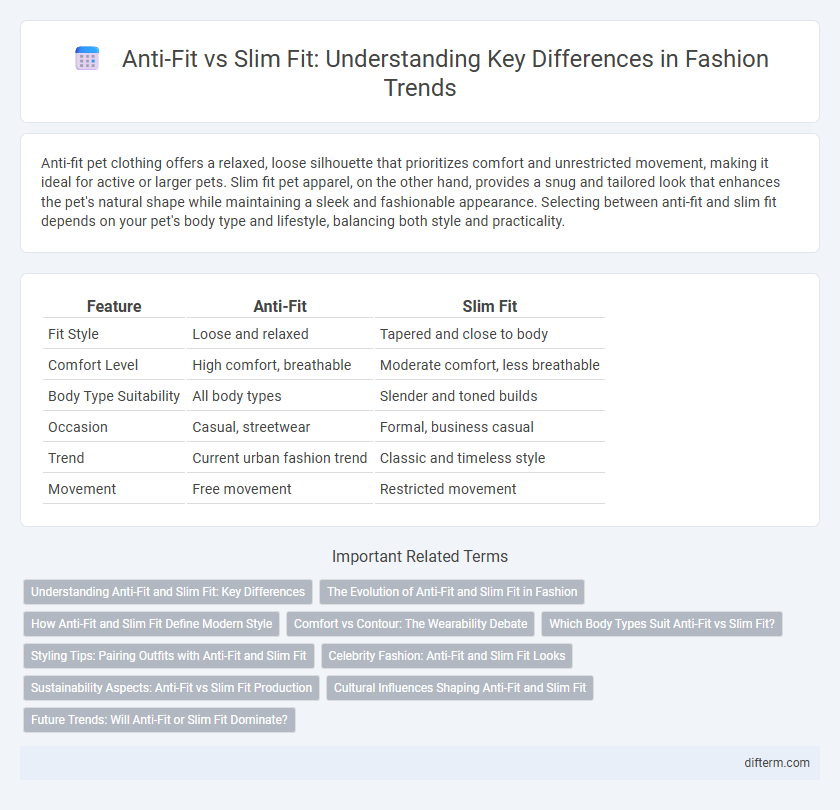Anti-fit pet clothing offers a relaxed, loose silhouette that prioritizes comfort and unrestricted movement, making it ideal for active or larger pets. Slim fit pet apparel, on the other hand, provides a snug and tailored look that enhances the pet's natural shape while maintaining a sleek and fashionable appearance. Selecting between anti-fit and slim fit depends on your pet's body type and lifestyle, balancing both style and practicality.
Table of Comparison
| Feature | Anti-Fit | Slim Fit |
|---|---|---|
| Fit Style | Loose and relaxed | Tapered and close to body |
| Comfort Level | High comfort, breathable | Moderate comfort, less breathable |
| Body Type Suitability | All body types | Slender and toned builds |
| Occasion | Casual, streetwear | Formal, business casual |
| Trend | Current urban fashion trend | Classic and timeless style |
| Movement | Free movement | Restricted movement |
Understanding Anti-Fit and Slim Fit: Key Differences
Anti-fit clothing embraces a loose, relaxed silhouette designed for maximum comfort and freedom of movement, often featuring oversized proportions and a casual aesthetic. Slim fit garments, in contrast, contour closer to the body with tapered lines that highlight the wearer's shape, providing a sleek, modern look favored in tailored and contemporary fashion. Understanding these key differences helps consumers choose styles that best match their comfort preferences and fashion intentions, whether prioritizing ease or a refined, form-fitting appearance.
The Evolution of Anti-Fit and Slim Fit in Fashion
The evolution of anti-fit and slim fit styles reflects a dynamic shift in fashion preferences, where anti-fit offers a relaxed, oversized silhouette emphasizing comfort and individuality, while slim fit showcases a tailored, body-hugging design that accentuates form and sophistication. Anti-fit gained prominence as a counter-movement to tight clothing, appealing to streetwear and casual wear enthusiasts who prioritize freedom of movement and unconventional aesthetics. Slim fit continues to dominate formal and business attire, symbolizing modern elegance and precision in men's and women's fashion.
How Anti-Fit and Slim Fit Define Modern Style
Anti-fit and slim fit represent distinctive fashion philosophies shaping modern style through silhouette and comfort. Anti-fit emphasizes relaxed, oversized shapes that promote ease and individuality, appealing to contemporary streetwear and casual trends. Slim fit highlights a tailored, close-to-body cut that enhances sleekness and sophistication, defining sharp, polished looks in modern menswear and womenswear.
Comfort vs Contour: The Wearability Debate
Anti-fit clothing prioritizes comfort with looser cuts that allow greater freedom of movement and breathability, ideal for casual wear and extended use. Slim fit garments emphasize contouring, hugging the body to showcase shape and offer a tailored, sleek appearance favored in formal and fashion-forward settings. The wearability debate hinges on balancing ease and comfort against a streamlined silhouette, influencing consumer choices based on lifestyle and aesthetic preferences.
Which Body Types Suit Anti-Fit vs Slim Fit?
Anti-fit clothing, characterized by its loose and relaxed silhouette, suits body types seeking comfort and a casual look, particularly those with athletic or broader frames who prefer to avoid clingy fabrics. Slim fit garments contour closely to the body, enhancing shapes and complementing lean or slender figures by providing a tailored appearance that defines natural lines. Choosing between anti-fit and slim fit depends on the desired style and body shape, with anti-fit offering breathability and ease, while slim fit emphasizes a sleek, fitted profile.
Styling Tips: Pairing Outfits with Anti-Fit and Slim Fit
Pair slim fit garments with structured outerwear and tailored accessories to accentuate a streamlined silhouette that enhances formal or business-casual looks. Anti-fit pieces work best with relaxed or oversized layers and chunky footwear, creating a balanced, streetwear-inspired ensemble that emphasizes comfort and effortless style. Mixing textures and monochrome palettes elevates both fits, ensuring versatility across various fashion settings.
Celebrity Fashion: Anti-Fit and Slim Fit Looks
Celebrity fashion showcases a dynamic contrast between anti-fit and slim fit styles, with stars like Harry Styles championing the oversized, anti-fit trend that emphasizes comfort and bold silhouettes. Conversely, celebrities such as Ryan Reynolds often opt for slim fit attire that highlights tailored cuts and sharp lines, creating a sleek and polished appearance. This juxtaposition in celebrity wardrobes reflects evolving fashion preferences, blending relaxed aesthetics with classic refinement to inspire diverse style expressions.
Sustainability Aspects: Anti-Fit vs Slim Fit Production
Anti-fit clothing typically requires less resource-intensive tailoring and fewer materials due to its looser, more forgiving shapes, contributing to lower waste in production compared to slim fit garments. Slim fit designs often demand precise cutting and more fabric usage to achieve a tailored appearance, potentially increasing fabric waste and energy consumption during manufacturing. Sustainable fashion brands increasingly favor anti-fit styles to reduce environmental impact through minimized production waste and enhanced garment longevity.
Cultural Influences Shaping Anti-Fit and Slim Fit
Anti-fit and slim fit styles reflect diverse cultural influences, with anti-fit emerging from streetwear and counterculture movements emphasizing comfort and individuality. Slim fit owes its popularity to modern urban fashion and media portrayals of sleek, tailored looks that highlight body shape. These fits symbolize distinct cultural values: anti-fit promotes rebellion against conventional norms, while slim fit aligns with contemporary ideals of sophistication and formality.
Future Trends: Will Anti-Fit or Slim Fit Dominate?
Future fashion trends indicate a growing preference for anti-fit silhouettes, driven by increasing demand for comfort and sustainable materials, appealing to younger, environmentally conscious consumers. Slim fit remains popular in formal and professional wear due to its tailored, sleek appearance that enhances body contours and provides a polished look. Market analysis suggests a hybrid approach could dominate, blending the relaxed feel of anti-fit with the structured elegance of slim fit to meet diverse consumer needs.
Anti-fit vs slim fit Infographic

 difterm.com
difterm.com